#Hamadan
Explore tagged Tumblr posts
Text

Ketubah (Jewish marriage contract), Hamadan, Iran 1943. Ink and block print on paper, 14 1/8 × 11 3/4 in. (35.9 × 29.8 cm).
#ketubah#ketubot#jewish art#jewish heritage#iranian jews#persian jews#mizrahi jews#hamadan#block print#judaism#uploads
13 notes
·
View notes
Text







Hamadan, Iran. 1967-69. Daniel Briskin.
2 notes
·
View notes
Text
The Legend of Queen Esther
For this week's culture blog, I read a scholarly article about whether or not Queen Esther and Mordechai were actually buried in Hamadan. This past weekend was the Jewish holiday of Purim, a celebration of Queen Esther, the Jewish wife of a Persian king who revealed her religious identity when one of the King's advisors announced his plan to exterminate the Jewish people in the kingdom. Esther is celebrated as she revealed to the King that she too was Jewish and encouraged him to stop the advisor, Haman's, evil plot and thus saved the Jewish people in the kingdom.
In Hamadan, Esther and Mordechai are allegedly buried in a set of modest tombs and its location is recognized as the only holy place for Jews in Persia. In 1067, Jewish Persian source Sahin describes Esther and Mordechai's dreams before dying inside the synagogue that their tombs are now in front of. There aren't any other sources on their place of burial until the 1850s, when Israel Ben Joseph visited Hamadan and explained how the Persian Jews came to the tombs once a month to pray and said that there was a community of about 500 Jews in Hamadan and three synagogues. Yehiel Fischel Castelman, a Galician Jew, and Jakob Pollak, Naser Al Din Shah's physician, both described the tombs as magnificent and of great importance to the Jewish people.
In spite of all of these accounts and the traditions of the Jews of Persia, the archaeologist Ernst Herzfeld and the lack of sources outside of Persia that say Esther and Mordechai were buried in Hamadan argue that these tombs are not the burial place of Esther and Mordechai. Herzfeld instead says they were buried in Susa and that Susandokt, the daughter of the Jewish Exilarch actually resides in the tomb.
I found these stories really interesting because my grandfather was from Hamadan and I'd never heard of him mentioning any Jewish holy sites there. I also did further research and found out that the Iranian regime actually added the tomb to its national heritage list in 2008. It was really surprising to read about the actual location where an iconic biblical figure, Esther, is supposedly buried and to discover that it was in Hamadan. Growing up, my family always celebrated Purim because there are not many Jewish holidays that detail the stories of Persian Jews, and it was really cool to read that there is an actual tomb in Iran that is protected because of this story and the religious traditions of Iranian Jews and Christians.
https://www.ou.org/life/history/where_is_the_tomb_of_mordechai_and_esther/
https://www.iranicaonline.org/articles/esther-and-mordechai

tomb of esther and mordechai in hamadan
لورن
6 notes
·
View notes
Text

«Supongamos que uno de nosotros sea creado de una sola vez y perfectamente, pero sus ojos están velados y no pueden ver las cosas exteriores; fue creado sosteniéndose en el aire, o, mejor aún, en el vacío, a fin de que la resistencia del aire que pudiera sentir no le impresionase. Sus miembros están separados para que no puedan encontrarse ni tocarse. Entonces reflexiona y se pregunta si su propia existencia está probada; sin tener duda alguna afirmará que existe. A pesar de esto, él no habrá experimentado sus manos, ni sus pies, ni lo íntimo de sus entrañas; ni un corazón, ni un cerebro, ni ninguna cosa exterior, sino que él afirmará que existe, sin esta que tenga una longitud, una anchura y una profundad.».
Avicena (Ibn Sĩnã): Sobre metafísica (antología). Revista de Occidente, pág. 53. Madrid, 1950.
TGO
@bocadosdefilosofia
#avicena#ibn sĩnã#Abū ‘Alī al-Husayn ibn ‘Abd Allāh ibn Sĩnã#ابو علی الحسین ابن عبدالله ابن سینا#علی الحسین ابن عبدالله ابن سین ابوا#filosofía persa#filosofía medieval#ser#existencia#intuición del ser#metafísica#miguel cruz hernández#teo gómez otero#museum at buali sina mausoleum#hamadan#irán
2 notes
·
View notes
Text
اعدام ۱۸ زندانی در زندانهای کهنوج، اصفهان، قزوین، کرج، همدان، قم، شیراز، دزفول، ارومیه و مشهد
Continue reading اعدام ۱۸ زندانی در زندانهای کهنوج، اصفهان، قزوین، کرج، همدان، قم، شیراز، دزفول، ارومیه و مشهد
#and Mashhad.#Dezful#Execution of 18 prisoners in the prisons of Kahnuj#Hamadan#human rights#Human rights organization MKN#Isfahan#Karaj#MKN314#Qazvin#Qom#Shiraz#Urmia#مجید جشلو#محمود بامری#محمدعلی نجفی#محسن مختاری#نورمراد گراوند#ناصر محمدی هنگروانی#پاشا پشتو#افغانستان#ایران-Iran#اعدام#اعدام ها-Executions#جنایات جمهوری اسلامی-The crimes of the Islamic Republic#جاوید احمدخانی#حقوق بشر - human rights#خبر فوری#رامین محمدوند#رسول فیلی
0 notes
Text

Carrefour (Hamadan, Iran)
#hamadan#hamedan#iran#travel#voyage#photography#photographie#travel photography#photographie de voyage#street#rue#noir et blanc#black and white#street photography#photographie de rue#people#people of the world#travel iran#voyage en iran#photographers on tumblr
1 note
·
View note
Text
This Week in Prophecy: Iran Under Attack, Iran & Turkey Quake, Russian Navy Goes West
This Week in Prophecy: Iran Under Attack, Iran & Turkey Quake, Russian Navy Goes West
On This Week in Prophecy: Over the weekend, Iran has been under a coordinated attack. According to various outlets, Israel and the United States are suspected. To sum up an eventful evening in #Iran, some mysterious incidents at:1⃣ Esfahan in a MODAFL facility (confirmed)2⃣ Azarshahr in East Azerbaijan Province (massive fire)3⃣ Karaj and Tehran (footage circulating, unclear)4⃣ Hamedan & Dezful…

View On WordPress
#Admiral Gorshkov#Al Jarrah airbase#Aleppo#drones#earthquakes#Hamadan#Hezbollah#Iran#Isfahan#Israel#Khoy#Middle East#Missiles#Palestinians#Russia#Secretary of State Antony Blinken#Syria#Tabriz#Tehran#Turkey#United States
0 notes
Photo
This solid gold ornament is in the form of a roundel with two projecting elements that have slots for the attachment of a strap. The rim of the roundel, consisting of eighteen thumbnail-shaped cells for turquoise inlay in the manner of some Sarmatian roundels, frames the openwork figure of an eagle in high relief. Grasping a small, crouching animal in its talons, the bird perches in three-quarter view, facing right, with its chest extended and the rest of its body receding into the background. Its wings are outspread, the one on the left seen emerging from behind the swelling of the chest and the one on the right receding into the back plane. The body and legs carry ridges and linear patterning to suggest the texture of feathers. The bird's head is in profile, with a cell for the prominent ear, a protrusion at the eye area, a curved beak, and a downcurved line for the mouth. The entire figure is worked in the round, although the back is distorted and not as carefully finished as the front.
The eagle's prey has been variously identified as an antelope, a goat, and a hare. Turquoise is inlaid in its large ear and in several places on its body. The tabs on either side of the roundel have cells for inlays at the corners in the form of debased acanthus leaves.
This piece is one of a pair; its mate, in the British Museum, London, depicts an eagle facing the opposite way. It was thought by Ernst Herzfeld to be part of a treasure found in 1910–11 in a chamber tomb near Nihavend in Iran. Herzfeld speculated that this trove had belonged to an aristocratic Parthian family and had originally included a group of Roman gold coins of the first to second century A.D. that surfaced independently in modern times. Another related piece of jewelry, found in excavations at Dalverzin Tepe in Uzbekistan, can be dated archaeologically to the first century A.D.
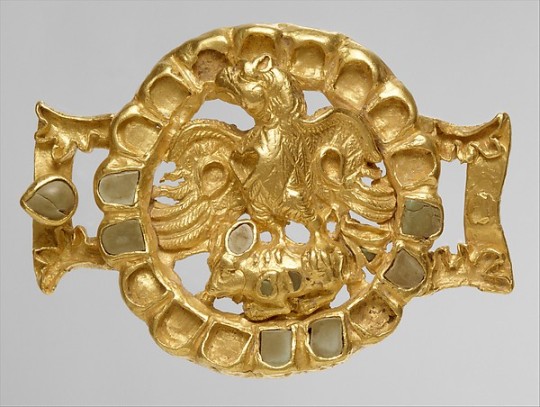
Gold and turquoise clasp depicting an eagle and prey. The piece is from Parthia (modern-day Iran) and dates to the 1st or 2nd century CE. From the collection of the Metropolitan Museum of art.
#history#jewellery#clothing#parthia#samartians#iran#uzbekistan#hamadan province#surxondaryo region#nahavand#dalverzin tepe#ernst herzfeld#turquoise#belts
25 notes
·
View notes
Text
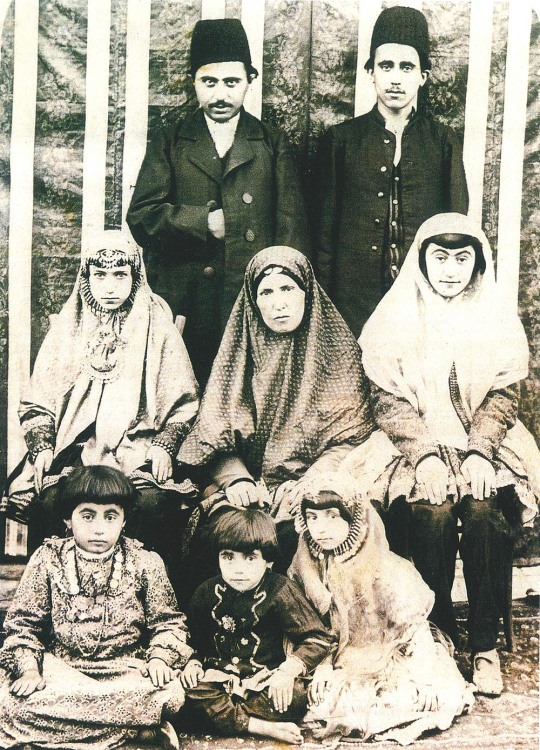
Jewish wedding photo from Hamadan, Iran, 1910. The bride is sitting in the middle row, left.
This photograph captures the mix of traditions that influenced Persian Jewish wedding customs, each designed to ward off curses and ensure fertility, economic success and safety for the bride and her future children. The wedding jewelry functioned both as a decoration and as a talisman against the evil eye. The fear of “cheshm khordan” (lit. translated to being struck by the eye), has been embedded in Iranian culture since the time of the Zoroastrians, and is deeply rooted in Persian Jewish tradition as well. For another ritual, known as henna-bandon, women gather in the home of the bride’s family to put henna on the bride’s hair and hands and to light esphan, the seeds of wild rue, in order to keep the evil eye away from home and loved ones. The esphan is placed on a stove, and once it starts popping, the fire is turned down and the bride inhales the scent of the herb.
280 notes
·
View notes
Text
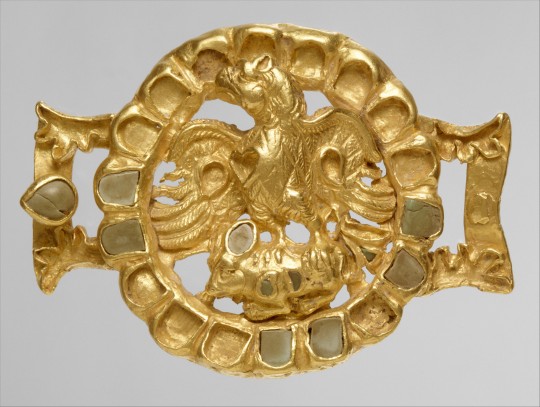
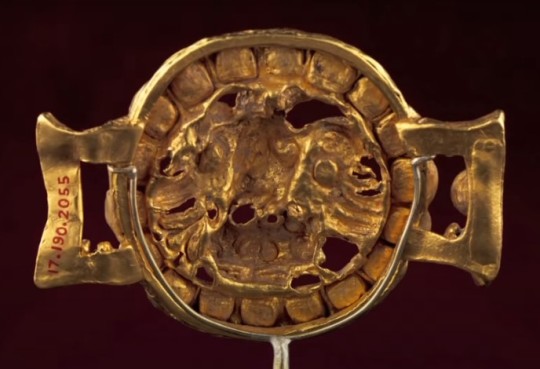
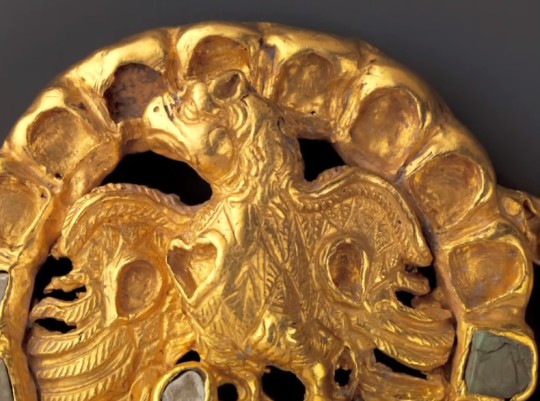

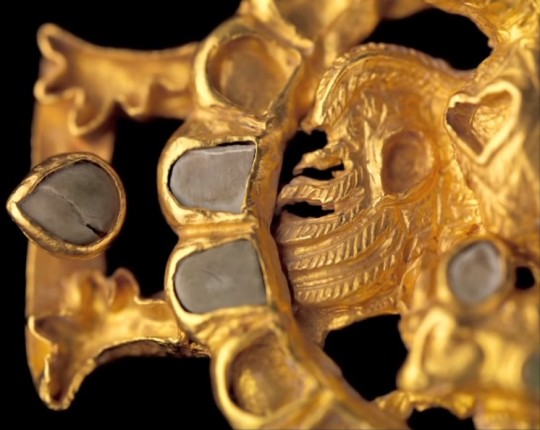

Gold clasp of eagle, possibly belonging to the House of Karen, 1st-2nd C. CE. Found in Nahavand. The House of Karen seems to have been descended from the Parni, who were themselves an offshoot of the Scythians. Ernst Herzfeld wrote that this item probably belonged to their house.
"House of Karen (Middle Persian: Kārēn; Parthian: 𐭊𐭓𐭍𐭉, romanized: Kārēn; Persian: کارن, romanized: Kārin or Kāren), also known as Karen-Pahlav (Kārēn-Pahlaw) was one of the Seven Great Houses of Iran during the rule of Parthian and Sassanian Empires. The seat of the dynasty was at Nahavand, about 65 km south of Ecbatana (present-day Hamadan, Iran). Members of House of Karen were of notable rank in the administrative structure of the Sassanian empire in multiple periods of its four century-long history.
The Karens, Karan-Vands, Qarinvand dynasty or Karen-Pahlevi as they are also called, claimed descent from Karen, a figure of folklore and son of the equally mythical Kaveh the Blacksmith. Their historical origin however may be that the Karens, along with the House of Mihran, were descended from the Arsacids. According to Movses Khorenatsi, this descent was via one of the three sons of Phraates IV, also named Karen. The fact that Karen may also have been among the family names of the Arsacid dynasty may give credence to this theory.
The first verified reference to the Karenas was during the Arsacid era, specifically as one of the feudal houses affiliated with the Parthian court. In this they were similar to the House of Suren, the only other attested feudal house of the Parthian period. Following the conquest of the Parthians, the Karenas allied themselves with the Sassanids, at whose court they were identified as one of the so-called "Parthian clans". The Armenian Kamsarakan family was a branch of the House of Karen."
-taken from Wikipedia
youtube
#scythian#iranian#ancient persia#ancient history#history#art#antiquities#museums#archaeology#heart symbol#Youtube
210 notes
·
View notes
Text
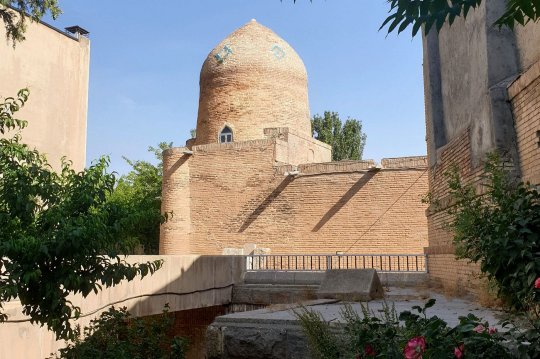
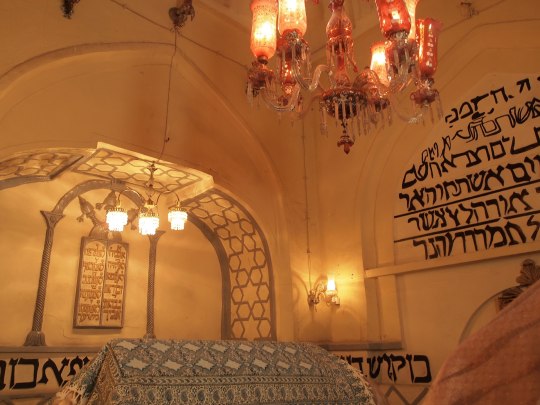

the tomb of esther and mordechai in hamadan, iran. the site is believed by iranian jews and christians to house the bodies of the aformentioned biblical figures, and is an important site of pilgrimage for both. the earliest known account of it was made by the jewish traveller benjamin of tudela in the 11th century.
the interior has been renovated so many times throughout the centuries that the original hebrew inscriptions on the walls have been lost in several paint-overs. what we're left with today is practically gibberish.
#iran#architecture#interior#worship#jewish#mizrahi#persian jews#christian#shared space#my posts#iranian christians = assyrians armenians and recent (mostly persian) converts (though the latter can't be open about it)#also i learned posting this that the book of esther isn't mentioned in the quran. i wonder why
72 notes
·
View notes
Text
The fireplace:

This was actually an Achaemenid Persian lion with eagle wings. It was discovered for the first time in Hamadan(hegmataneh). During the Achaemenid period, it was one of the golden and royal vessels in which they drank in it. It's called "rhyton"
500 years BC



Also pictures are from the museum and not mine
What interesting things have you noticed in the movies?⚜️
#kingdom of heaven#baldwin iv#fandom#king baldwin iv#kingdom of heaven 2005#facts#art#history#ancient persia#ancient history#the leper king#fire place#decoration#history facts#achaemenid#movies
107 notes
·
View notes
Text
Dialects in Hamadan

For this week’s culture blog, I decided to read an article about the Hamadan Jewish dialect. I was surprised to learn of the existence of the Hamadan Jewish dialect because my grandfather was from Hamadan and always spoke of learning Hebrew when he was a child. He always had said that his hometown (Hamadan) did not have many Jewish people and so it was interesting to learn about the existence of this dialect. My grandfather was also a linguist, priding himself on speaking Italian, French, German, English, Farsi, Hebrew, and Russian, which makes me further shocked that he never discussed the existence of the dialect or spoke it!
In the article, the Jewish community in Hamadan was estimated to be around 13,000 people in 1920 and less than 1,000 by 1969, with a half of this population originating from Malayer, Tuyserkan, and Kurdistan. () According to the study of the dialect, after the 1940s children were not raised speaking the dialect and that by 1969 it was rarely spoken at home.()
Phonologically, the dialect had some of the markers of Southwestern Iranian, despite belonging to the Central Plateau Dialect group of Northwestern Iranian languages. Noun modifiers also use ezafe connectors in the same way we have learned in class, with the attachment of “e” after nouns, though the negation of verbs is different than the way we learned to negate verbs in class. “Ne” is used more than “na” and “ni” to negate verbs.
It is difficult to extract the exact origins of the dialect because of the mix of Northwestern and Southwestern Iranian and Central Plateau dialects and the inability to pinpoint the exact migration pattern of the Jewish community. Reading about this dialect was incredibly interesting to me because I had always thought of my grandfather’s linguistic interests as separate. I would never have imagined the existence of a Hamadan Jewish dialect specifically, as in my head my grandfather’s knowledge of Hebrew and Farsi were completely separate. The Hamadan Jewish dialect instead suggests that there were members of the Jewish community who combined phonological aspects of both languages and in turn their Jewish Iranian identities.
Article’s Citation: Stilo, David (2012, December 12). HAMADĀN ix. JEWISH DIALECT Encyclopædia Iranica, http://www.iranicaonline.org/articles/hamadan-ix
لارن
1 note
·
View note
Text

Carpet, 1800s, Hamadan, Iran.
15 notes
·
View notes
Text
Asymptomatic Children as a Missing Link in Preventing COVID-19 Transmission - Published June 1, 2024
Abstract Background: Investigating the prevalence of the coronavirus disease 2019 (COVID-19) infection in asymptomatic children who have been in close contact with symptomatic individuals is instrumental for refining public health approaches, protecting vulnerable populations, and mitigating the broader impact of the pandemic. Accordingly, this study aimed to evaluate the incidence of COVID-19 infection in asymptomatic children who had been in close contact with parents exhibiting COVID-19 symptoms.
Study Design: A cross-sectional study.
Methods: The present cross-sectional study was conducted on 175 asymptomatic children who had been in close contact with COVID-19 confirmed cases in Hamadan County from March 2021 to August 2021. Reverse transcription polymerase chain reaction (RT-PCR) testing was performed on all asymptomatic children who had been in close contact with an individual with COVID-19. Furthermore, multiple logistic regressions were conducted to determine the predictors of COVID-19 transmission from family members to children.
Results: Out of the 175 children in close contact with index cases, 53 (30.29%) tested positive for COVID-19 through PCR. Regarding factors related to the index case, male cases (Adjusted odds ratio [AOR]=2.29; 95% confidence interval [CI]: 1.03-5.09, P=0.041), rural dwellers (AOR=3.22; 95% CI: 1.02-10.16, P=0.046), illiterate cases (AOR=8.45; 95% CI: 1.76-40.65, P=0.008), and cases presenting with nasal congestion symptoms (AOR=9.12; 95% CI: 2.22-37.40, P=0.002) were more prone to transmitting the virus to children who had close contact with them.
Conclusion: The findings of the present study suggested that asymptomatic COVID-19 infection in household contacts is significant in children who were in close contact with a COVID-19-positive patient. Therefore, it is crucial to continue to monitor this group closely.
#covid#mask up#coronavirus#wear a mask#pandemic#covid 19#sars cov 2#still coviding#public health#wear a respirator
14 notes
·
View notes
Text







#Repost @poetryandgahwa
Wise Quotes from Ibn Sina…
"Ibn Sina, (also known as Avicenna) was a polymath born in 980 AD in Bukhara, present-day Uzbekistan. He made significant contributions to medicine, philosophy, astronomy, and mathematics. His most famous work, “The Canon of Medicine,” became a standard medical textbook for centuries.
Ibn Sina’s philosophical masterpiece, “The Book of Healing,” explored various topics in metaphysics and ethics. He died in 1037 AD in Hamadan, Iran, leaving a lasting legacy in the history of science and philosophy."
9 notes
·
View notes